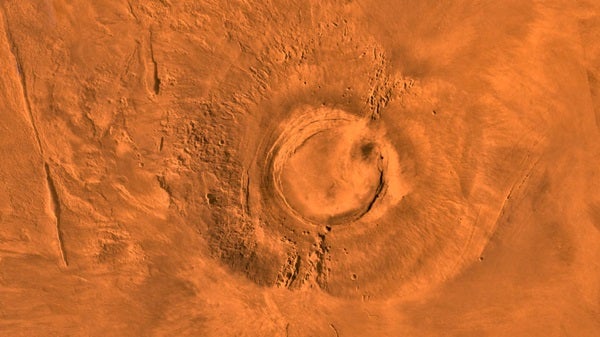The rough estimate for the dinosaurs’ extinction was about 50 million years ago, but NASA reveals that may not be the only thing that disappeared around that time.
New research from NASA shows that Arsia Mons, a large volcano just south of Mars’ equator, has been inactive for about 50 million years.
The last time Arsia Mons erupted was in the bowl-shaped depression at the top of the volcano, called the caldera. The caldera is 68 miles (110 kilometers) across and has enough space to hold all of Lake Huron with some spare room.
Researchers discovered Arsia Mons has 29 vents, or openings in the crust where the lava pours out. During their peak, the vents spewed 0.25 to 2 cubic miles (1 to 8 cubic kilometers) of magma, which helped contribute to the volcano’s size over time.
“We estimate that the peak activity for the volcanic field at the summit of Arsia Mons probably occurred approximately 150 million years ago — the late Jurassic period on Earth — and then died out around the same time as Earth’s dinosaurs,” Jacob Richardson, a postdoctoral researcher at NASA’s Goddard Space Flight Center in Greenbelt, Maryland, said in a press release. “It’s possible, though, that the last volcanic vent or two might have been active in the past 50 million years, which is very recent in geological terms.”
Richardson and his colleagues at the University of South Florida developed a computer model that combined information about the boundaries of the lava flows and the number of large craters in the area to date the lava flows from oldest to youngest.
Studying these volcanoes helps researchers understand Mars’ history, composition, and interior structure.
“A major goal of the Mars volcanology community is to understand the anatomy and lifecycle of the planet’s volcanoes. Mars’ volcanoes show evidence for activity over a larger time span than those on Earth, but their histories of magma production might be quite different,” Jacob Bleacher, a planetary geologist at Goddard and a co-author on the study, said. “This study gives us another clue about how activity at Arsia Mons tailed off and the huge volcano became quiet.”
This study was presented March 20 at the Lunar and Planetary Science Conference in Texas and was published in Earth and Planetary Science Letters.










